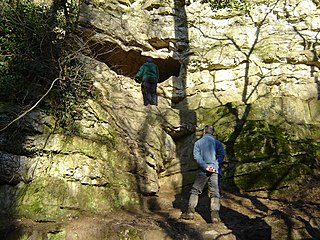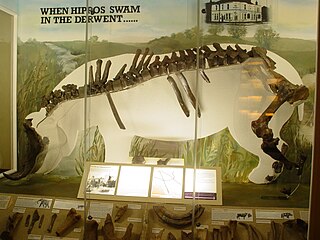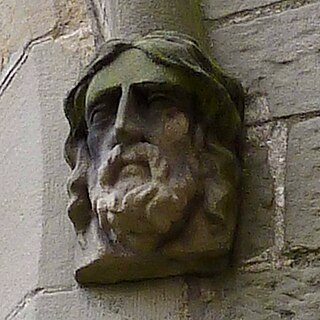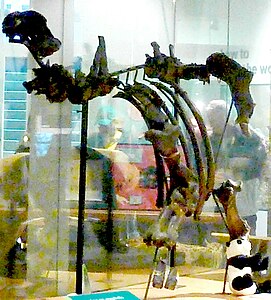
The hippopotamus, also shortened to hippo, further qualified as the common hippopotamus, Nile hippopotamus, or river hippopotamus, is a large semiaquatic mammal native to sub-Saharan Africa. It is one of only two extant species in the family Hippopotamidae, the other being the pygmy hippopotamus. Its name comes from the ancient Greek for "river horse" (ἱπποπόταμος).

The pygmy hippopotamus or pygmy hippo is a small hippopotamid which is native to the forests and swamps of West Africa, primarily in Liberia, with small populations in Sierra Leone, Guinea, and Ivory Coast. It has been extirpated from Nigeria.

Aetokremnos is a rock shelter near Limassol on the southern coast of Cyprus. It is situated on a steep cliff site c. 40 m (131.23 ft) above the Mediterranean sea. The name means "Cliff of the eagles" in Greek. Around 40 m2 (430.56 sq ft) have been excavated and out of the four layers documented, the third is sterile.

Wortley is an inner city area of Leeds, West Yorkshire, England. It begins one mile to the west of the city centre. The appropriate City of Leeds ward is called Farnley and Wortley.

Kirkdale Cave is a cave and fossil site located in Kirkdale near Kirkbymoorside in the Vale of Pickering, North Yorkshire, England. It was discovered by workmen in 1821, and found to contain fossilized bones of a variety of mammals not currently found in Great Britain, including hippopotamuses, elephants and cave hyenas.
Teleosaurus is an extinct genus of teleosaurid crocodyliform found in the Middle Jurassic Calcaire de Caen Formation of France. It was approximately 3 metres (10 ft) in length and weighed 60 kg (130 lb). The holotype is MNHN AC 8746, a quarter of a skull and other associated postcranial remains, while other fragmentary specimens are known. The type species is T. cadomensis, but a second species, T. geoffroyi may also exist. It was previously considered a wastebasket taxon, with many other remains assigned to the genus.

The Leeds Industrial Museum at Armley Mills is a museum of industrial heritage located in Armley, near Leeds, in West Yorkshire, Northern England. The museum includes collections of textile machinery, railway equipment and heavy engineering amongst others.

Lemerle's dwarf hippopotamus is an extinct species of Malagasy hippopotamus.

Several species of Malagasy hippopotamus lived on the island of Madagascar but are now believed to be extinct. The animals were very similar to the extant hippopotamus and pygmy hippopotamus. The fossil record suggests that at least one species of hippopotamus lived until about 1,000 years ago and other evidence suggests that the species may have survived until much more recently. The taxonomy of these animals is not resolved and not widely studied.

Leeds City Museum, originally established in 1819, reopened in 2008 in Leeds, West Yorkshire, England. It is housed in the former Mechanics' Institute built by Cuthbert Brodrick, in Cookridge Street. It is one of nine sites in the Leeds Museums & Galleries group.

The Yorkshire Museum is a museum in York, England. It was opened in 1830, and has five permanent collections, covering biology, geology, archaeology, numismatics and astronomy.

The Museum of Osteology, located in Oklahoma City, Oklahoma, U.S., is a private museum devoted to the study of bones and skeletons (osteology). This museum displays over 450 skeletons of animal species from all over the world. With another 7,000 specimens as part of the collection, but not on display, this is the largest privately held collection of osteological specimens in the world. The museum is an entity of its parent company, Skulls Unlimited International.

The Allenton Hippo is a hippopotamus skeleton that was found in Allenton, Derby, England, in 1895. The skeleton is exhibited in Derby Museum and Art Gallery and is 3 metres (9.8 ft) in length. It is celebrated today in a sculpture near to where the skeleton was discovered.

William Ingle was an architectural sculptor in Leeds, West Yorkshire, England. He specialised in delicately undercut bas relief and small stand-alone stone sculptures of natural and imaginary flora and fauna on churches and on civic, commercial and domestic buildings. He was apprenticed to his uncle Robert Mawer. After Mawer's death in 1854 he worked in partnership with his aunt Catherine Mawer and his cousin Charles Mawer in the company Mawer and Ingle. Notable works by Ingle exist on Leeds Town Hall, Endcliffe Hall, Sheffield and Moorlands House, Leeds. He sometimes exhibited gentle humour in his ecclesiastical work, such as faces peering through greenery, and mischievous humour on secular buildings, such as comic rabbits and frogs among foliage. He died of tuberculosis at age 41 years, having suffered the disease for two years.

John Wormald Appleyard was a British sculptor and monumental mason based in Leeds, West Yorkshire, England.

The Leeds Tiger is a taxidermy-mounted 19th-century Bengal tiger, displayed at Leeds City Museum in West Yorkshire, England. It has been a local visitor attraction for over 150 years.

William Gott, was a British wool merchant, mill owner, philanthropist towards public services and art collector from Leeds, West Riding of Yorkshire, England.

James Arnold Dickinson, MBE, is a British conservation-restoration taxidermist who repaired mounted animal skins and skeletons for museums in the United Kingdom for 40 years. Among his restoration works are the Leeds Irish elk, the Leeds polar bear, the Armley Hippo, and the Warrington seal.

Hippopotamus madagascariensis, the Madagascar or Madagascan dwarf hippopotamus, is an extinct species of hippopotamus, endemic to the island of Madagascar. Known only from bones, it is believed to have gone extinct sometime after 1500. It was one of three hippopotamus species, the Malagasy hippopotamuses, which were native to Madagascar and are all extinct.

Harry Ferris Brazenor was a British taxidermist. He was known especially for his work for Manchester and Salford museums, besides other institutions in Northern England. At Manchester Museum he was recognised for his taxidermy-mounted sperm whale skeleton, giraffe, polar bear, and a wolf with painted "blood" on its teeth. His work for Salford Museum included an Asian elephant displayed next to a tiny shrew. His Salford tiger was transferred to Leeds City Museum and is still displayed there. For Hancock Museum at Newcastle-on-Tyne he mounted a bison bull, and for the former Belle Vue Zoological Gardens he mounted an Indian rhinoceros.


























